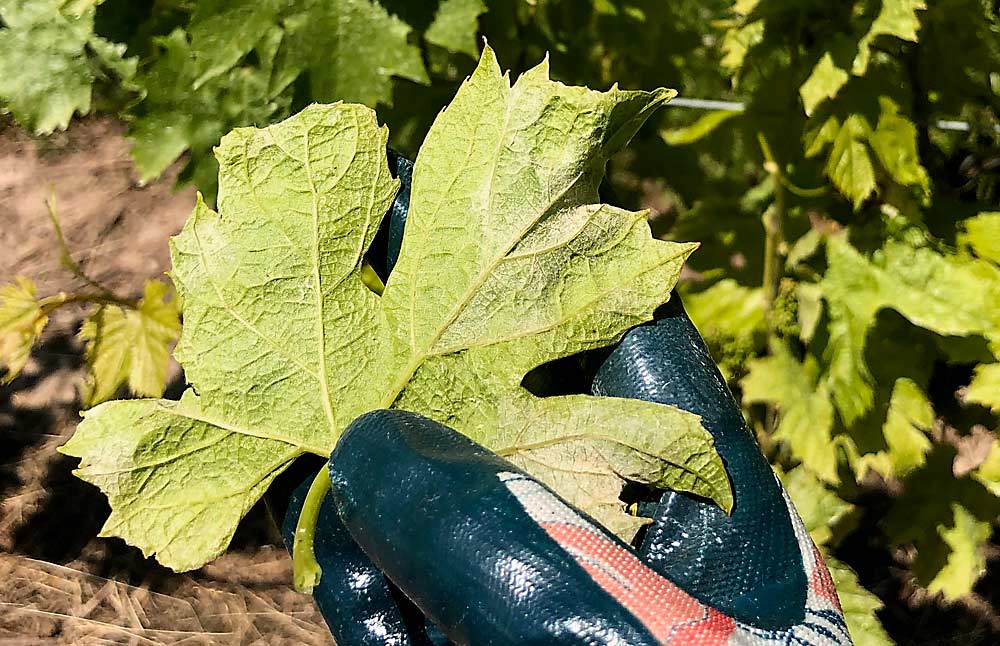Swipe right for easier pathogen detection in the vineyard
[ad_1]

Now that the FRAME Network project has wrapped up, what have we learned about fungicide resistance in grape powdery mildew?
Quite a bit, it turns out — and the path has been laid for more discoveries. Among other things, we can now test for powdery mildew and fungicide resistance with the swipe of a hand through a vineyard.
In a January webinar hosted by Penn State Extension, university researchers from several states discussed the project’s achievements. As members of FRAME — short for Fungicide Resistance Assessment, Mitigation and Extension — the researchers spent four years studying fungicide resistance in grape pathogens, with an emphasis on wine grapes and powdery mildew. The project, funded by the U.S. Department of Agriculture’s Specialty Crop Research Initiative, ran from 2019 through 2022, with some wrap-up work done in 2023.
Powdery mildew poses a nationwide problem for grape growers, with major economic impacts and a long history of requiring fungicide management. Unfortunately, the pathogen has a history of developing resistance to fungicides. And because there hasn’t been an effective system to monitor resistance or predict when it will appear, it’s usually identified only after management failures, according to the webinar speakers.
FRAME research focused on fungicides in the FRAC 11 group, which are commonly used in grapes and other specialty crops. But the popularity of FRAC 11 fungicides has led to pathogens developing greater resistance to them over time, said Michelle Moyer, FRAME’s project director and a Washington State University viticulture extension specialist.

Most FRAC 11 fungicides were registered in grapes two decades ago. By about 2009, researchers started to find pathogen resistance to that fungicide group, and by 2015 the resistance was fairly widespread, said Michigan State University small fruit and hop pathologist Tim Miles.
Tools developed or utilized by FRAME researchers, including the “glove swab method” and DNA testing, can greatly simplify and shorten the process for growers to detect fungicide resistance in powdery mildew. Using the glove swab method, you simply walk through a vineyard row and rub your hand across the vines and leaves. You then rub a swab across your hand to collect a testable sample of whatever is lurking on the leaves. Those swabs can then be sent to a lab for testing with a rapid PCR (polymerase chain reaction)-based DNA test to detect powdery mildew, and also to detect if the powdery mildew has developed fungicide resistance, Moyer said.
The glove swab method was developed by Sarah Lowder when she was a graduate student at Oregon State University. Now an extension viticulture specialist at the University of Georgia, Lowder told Good Fruit Grower that the “glove swabs” do not actually require gloves. You can run your bare hand through a vineyard, too, with no significant difference in results.
Moyer said the glove swab method is a faster and cleaner way to test for powdery mildew and fungicide resistance than collecting leaf samples or samples from spore traps, but the cost of PCR testing is still a barrier to widespread adoption. The more samples submitted to a university or commercial diagnostic lab, the more the cost of testing goes down, but at this point growers who want quicker results will have to pay a higher price.

Moyer wants to continue studying fungicide resistance via a project that’s similar to FRAME but smaller, using what they’ve learned to find better ways to test for resistance in other pathogens, including downy mildew and botrytis.
During the webinar, Moyer noted that powdery mildew’s resistance to FRAC 11 fungicides seems to increase over the course of the growing season. They’re not sure why, but it might be a combination of pathogen behavior and vineyard spray practices.
The end goal of all this research is to give grape growers a cheap, easy and fast way to detect the pathogens in their vineyards, as well as any fungicide resistance in those pathogens. That kind of information would greatly aid their management decisions, Moyer said.
“It would be really nice to take one sample and learn a lot about that vineyard and be able to plan fungicide choices accordingly,” MSU pathologist Miles said.
—by Matt Milkovich

















